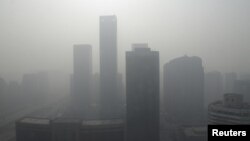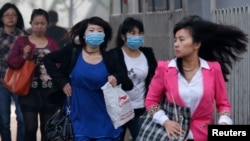BEIJING —
Large parts of China continue to be enveloped in a sea of smog and national weather forecasters are warning that the pollution could linger until mid-week. The bad air stretches from cities in the north to the far south and has contributed to flight delays, forced schools to move activities indoors and led to a rise in respiratory cases at local hospitals.
Although pollution levels were slightly lower on Monday in China’s capital, Beijing, they were still lingering at levels environmentalists say are hazardous and protection, such as facemasks, is recommended.
In some of the worst hit areas - such as Beijing, Hebei, Tianjin, Henan and Shandong - visibility was less than one kilometer and in some cases less than 200 meters.
The lack of visibility has led to the closure of highways, cancellation of flights and postponement of wide range of sport activities.
On Saturday, an air quality station at the U.S. Embassy recorded particulate matter or PM 2.5 levels - nearly 900 micrograms per cubic meter. The World Health Organization recommended maximum daily level of PM 2.5 is 20 micrograms per square meter.
Fine particles in the air, which are about 1/30th the diameter of a human hair, come from many different sources, such as coal-burning power plants, construction and automobile exhaust.
Many people spent the weekend inside and on Monday as the pollution eased some, but showed no sign of letting up, some Beijing residents were reporting that it was difficult to find facemasks to buy.
Yoko, a 32-year-old public relations accountant, says that she went to buy a facemask this morning, but found that they were all sold out. However, she adds that even if you can find one, they are hard to wear outside because they feel so suffocating.
Yoko says her son is in the hospital and she believes that he has gotten a cough because of the bad air.
She says she just came from a nearby children’s hospital which was overcrowded with parents seeking help for their children. She says there were hundreds of kids there and doctors were scrambling to just keep up.
Fan, 27, who works for an international watch company says the pollution was having a big impact on his activities in the past few days that he has spent much more time than he’d like inside.
Fan says that he has been living in Beijing for four years and that he has never seen the pollution as bad as it is now. He says you always notice the dust when you fly into Beijing, but this is the first time that the PM 2.5 levels have become so serious. Like many people, he feels that government should continue its efforts to address the problem.
To try and rein in the pollution, officials have ordered dozens of construction sites to halt operations and businesses to reduce their emissions.
Pan Xiaochuan, a professor of public health at Beijing University, says that although increasing emissions of pollutants from sources such as automobile exhaust and industrial soot is part of the reason for the smog - the weather has made the situation worse.
Pan says that with relatively low air pressure, little wind and high humidity, it is difficult for pollutants to move on and they have become trapped in the lower atmosphere.
China’s capital has gone to great lengths to try to improve the quality of air in Beijing, relocating heavy industry and many factories outside of the city.
China’s leaders see pollution as a major challenge. When outgoing president Hu Jintao spoke to Communist Party leaders, late last year, he said the country needs to reverse the trend of ecological deterioration and build a beautiful China.
Although pollution levels were slightly lower on Monday in China’s capital, Beijing, they were still lingering at levels environmentalists say are hazardous and protection, such as facemasks, is recommended.
In some of the worst hit areas - such as Beijing, Hebei, Tianjin, Henan and Shandong - visibility was less than one kilometer and in some cases less than 200 meters.
The lack of visibility has led to the closure of highways, cancellation of flights and postponement of wide range of sport activities.
On Saturday, an air quality station at the U.S. Embassy recorded particulate matter or PM 2.5 levels - nearly 900 micrograms per cubic meter. The World Health Organization recommended maximum daily level of PM 2.5 is 20 micrograms per square meter.
Fine particles in the air, which are about 1/30th the diameter of a human hair, come from many different sources, such as coal-burning power plants, construction and automobile exhaust.
Many people spent the weekend inside and on Monday as the pollution eased some, but showed no sign of letting up, some Beijing residents were reporting that it was difficult to find facemasks to buy.
Yoko, a 32-year-old public relations accountant, says that she went to buy a facemask this morning, but found that they were all sold out. However, she adds that even if you can find one, they are hard to wear outside because they feel so suffocating.
Yoko says her son is in the hospital and she believes that he has gotten a cough because of the bad air.
She says she just came from a nearby children’s hospital which was overcrowded with parents seeking help for their children. She says there were hundreds of kids there and doctors were scrambling to just keep up.
Fan, 27, who works for an international watch company says the pollution was having a big impact on his activities in the past few days that he has spent much more time than he’d like inside.
Fan says that he has been living in Beijing for four years and that he has never seen the pollution as bad as it is now. He says you always notice the dust when you fly into Beijing, but this is the first time that the PM 2.5 levels have become so serious. Like many people, he feels that government should continue its efforts to address the problem.
To try and rein in the pollution, officials have ordered dozens of construction sites to halt operations and businesses to reduce their emissions.
Pan Xiaochuan, a professor of public health at Beijing University, says that although increasing emissions of pollutants from sources such as automobile exhaust and industrial soot is part of the reason for the smog - the weather has made the situation worse.
Pan says that with relatively low air pressure, little wind and high humidity, it is difficult for pollutants to move on and they have become trapped in the lower atmosphere.
China’s capital has gone to great lengths to try to improve the quality of air in Beijing, relocating heavy industry and many factories outside of the city.
China’s leaders see pollution as a major challenge. When outgoing president Hu Jintao spoke to Communist Party leaders, late last year, he said the country needs to reverse the trend of ecological deterioration and build a beautiful China.







